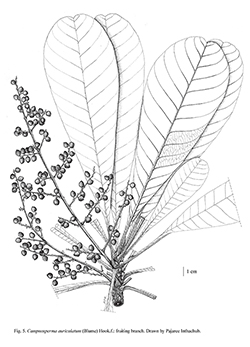e-Flora of Thailand
Volume 10 > Part 3 > Year 2010 > Page 276 > Anacardiaceae > Campnosperma
1. Campnosperma auriculatum (Blume) Hook.f.wfo-0000583053
Fl. Brit. Ind. 2: 41. 1876; Engl. in A.DC. & C.DC., Monogr. Phan. 4: 320. t.11. 1883; King, J. Asiat. Soc. Bengal, Pt. 2, Nat. Hist. 65: 495. 1896; Ridl., Fl. Malay Penins. 1: 534. 1922; Corner, Gard. Bull. Straits Settlem. 10: 253. 1939; Ways. Trees: 104. 1940; Ding Hou, Blumea 24: 5. 1978; Fl. Males. ser. 1, 8: 529. 1978; Kochummen, Tree Fl. Malaya 4: 18. 1989.— Buchanania auriculata Blume, Mus. Bot. Lugd. Bat.1: 185. 1850. Fig. 5.
Accepted Name : This is currently accepted.
Synonyms & Citations :
Description : Tree, 15–30 m high, with flat-topped crown; bark grayish-brown, cracked or papery scales; branches stout, warty, rusty tomentose when young. Leaves obovate, 20–34 by 5.5–16 cm, apex emarginate or deeply notched, base gradually decurrent into a narrowly winged petiole, coriaceous, glossy green above, paler below, lateral nerves 12–24 per side, oblique, arched along the margins, venation reticulate-scalariform, usually more distinct on lower surface; old leaves withering yellow to brownish-yellow; petioles 4–5.5 cm, narrowly winged and forming a pair of ear-like lobes. Panicles up to 50 cm long. Flower yellow; pedicels 6–7 mm long; calyx lobes triangular, 3–5 mm long; petals broadly elliptic or ovate, 1–1.5 by 5–6 mm; stamens 0.5–1.2 mm long; staminodes shorter and smaller; disc ca 1 mm in diam.; ovary ca 7–8 mm in diam. Drupe subglobose, 6–8 by 5–6 mm, green, dull reddish-purple when ripe; septum solid.
Thailand : PENINSULAR: Chumphon, Krabi, Satun (Thung Nui).
Distribution : Peninsula Malaysia (type), Singapore, Sumatra, Borneo.
Ecology : Common in lowland evergreen forests, up to 50 m alt.
Vernacular : Nang pron (นางปรน)(Peninsular).
Uses: The resinous sap is slightly poisonous. Fruits are eaten by birds.

